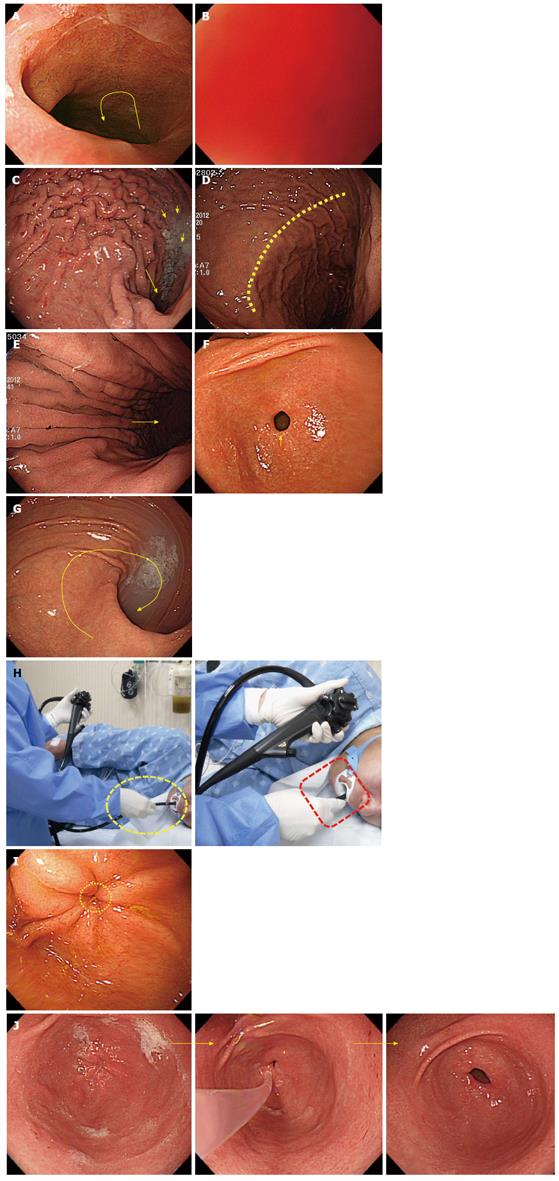Copyright
©The Author(s) 2015.
World J Gastroenterol. Jan 21, 2015; 21(3): 759-785
Published online Jan 21, 2015. doi: 10.3748/wjg.v21.i3.759
Published online Jan 21, 2015. doi: 10.3748/wjg.v21.i3.759
Figure 18 Intubation from stomach to duodenal bulb.
A: Gastroesophageal junction (GEJ). As the lower esophagus penetrates through the diaphragm and then starts to progress in the left posterior direction at a point where it is connected to the stomach, it is recommendable to insert the scope by twisting the shaft to the left side (arrow mark) during intubation into the stomach; B: Red-out sign. If the scope is only pushed in a straight line, it can subsequently touch the posterior wall of the gastric body, in which a red-out sign appears. If this happens, just pull back the scope a little. If air is insufflated, clear visibility will result; C: Gastric fold. When the scope is first inserted from the GEJ into the lumen of the stomach, a gastric fold is observed. Gastric fluid (small arrow marks) is usually retained in the gastric fold (greater curvature). The progression direction into the antrum of stomach is usually to the right side. The examinee in this image has a right sided progression of the surface into the antrum of stomach (5 o’clock direction, big arrow mark); D: Watershed. The watershed is also often called the saddle area, which serves as a landmark to divide the stomach into the gastric fold, fundus, and gastric body. It may not be clearly visible depending on the examinees or the condition of air insufflation; E: Advancement into the antrum of stomach; F: Distal antrum. The pyloric ring in a circle-shape is observed (arrow mark); G: Endoscopic image of cascade stomach. As the deflection angle of the cascade stomach is extremely sharp, a beginner may encounter difficulty advancing the scope into it; H: Tips for the insertion of the scope into the pyloric ring. When the endoscopy is performed in the stomach, it is a common practice to hold a shaft by keeping some distance from the mouth of the examinee (approximately 10 cm). However, especially when inserting the distal tip into the pyloric ring, it is advisable to hold it short (dotted rectangle) because it can transfer force to the tip more efficiently, to help advance it into the pyloric ring; I: Closed pyloric ring, a challenging configuration for beginners; J: Injection of warm water into the pyloric ring. The injection of warm water is helpful in inserting the scope into the pyloric ring.
- Citation: Lee SH, Park YK, Cho SM, Kang JK, Lee DJ. Technical skills and training of upper gastrointestinal endoscopy for new beginners. World J Gastroenterol 2015; 21(3): 759-785
- URL: https://www.wjgnet.com/1007-9327/full/v21/i3/759.htm
- DOI: https://dx.doi.org/10.3748/wjg.v21.i3.759









